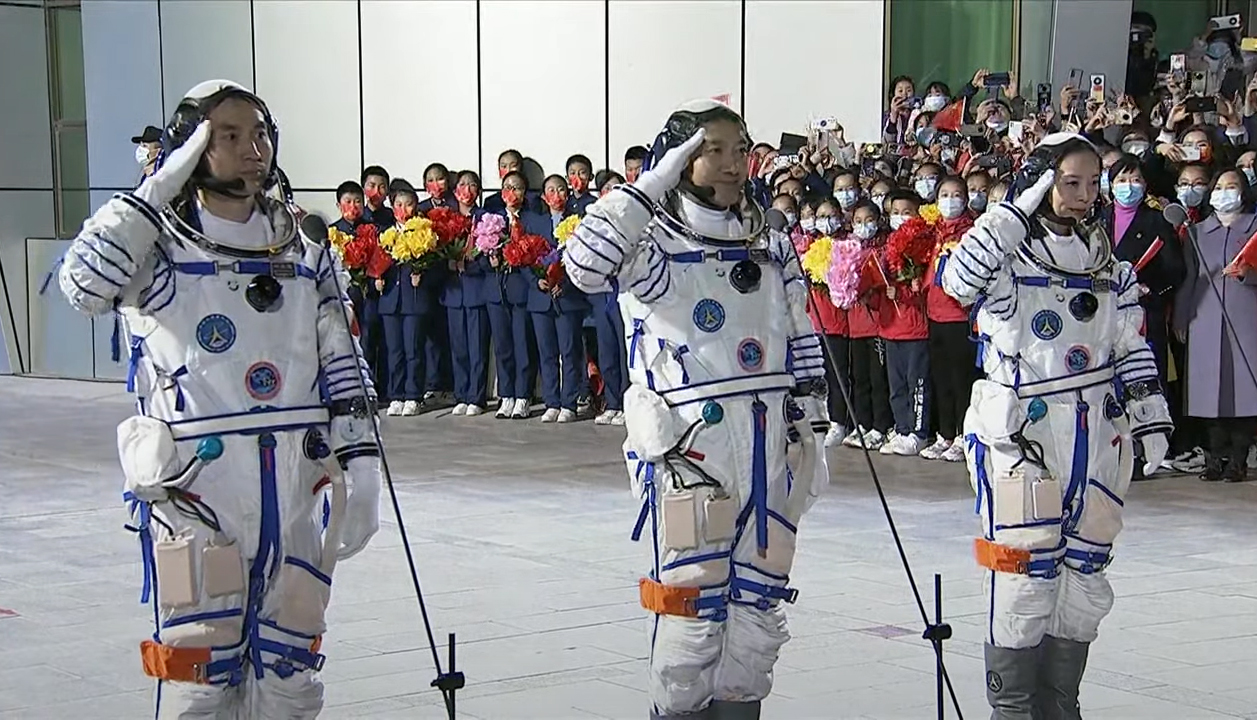China launches Shenzhou 13 astronauts on historic mission to new space station
China's second crewed mission to its new space station is underway.
The nation's Shenzhou 13 spacecraft launched from Jiuquan Satellite Launch Center in the Gobi Desert today (Oct. 15), rising off the pad atop a Long March 2F rocket at 12:23 p.m. EDT (1623 GMT; 00:23 Oct. 16 local time).
Shenzhou 13 and its three passengers — commander Zhai Zhigang, Wang Yaping and Ye Guangfu — are headed toward Tianhe, the core module of the Tiangong space station that China is building in low Earth orbit.
"Please rest assured that we will definitely succeed in this mission," Zhai told mission officials as he headed to pad before today's liftoff. (Zhai spoke in Mandarin; the translation was provided by Chinese TV station CCTV, which webcast the launch.) After reaching orbit, Zhai reported the crew was doing fine and all systems were nominal.
Related: The latest news about China's space program


If all goes according to plan, Shenzhou 13 will meet up with Tianhe tonight, about eight hours after launch.
Tianhe has only been aloft since April, but the module has already hosted one crewed visit — Shenzhou 12, which launched in June and returned to Earth last month. The three-month mission was China's longest-duration human spaceflight to date, but Shenzhou 13 will wreck that record, racking up six months aboard Tianhe ("Harmony of the Heavens").
Breaking space news, the latest updates on rocket launches, skywatching events and more!
Shenzhou 13 will break new ground in another way as well: Wang will become the first woman to live aboard the core module. (The Shenzhou 12 crewmembers were all men.)
This is the second spaceflight for the 41-year-old Wang. She also flew on Shenzhou 10, which visited China's Tiangong 1 prototype space lab for two weeks in 2013.
Zhai, 55, is also a spaceflight veteran, having served on the Shenzhou 7 mission in 2008. During that three-day flight, he conducted China's first-ever spacewalk.
Shenzhou 13 is the first spaceflight for Ye, who is 41.
"I feel very proud," Ye said during a prelaunch press conference on Thursday (Oct. 14). (He spoke in Mandarin; the translation was provided by the Chinese TV network CGTN.)
"For me personally, this is a great challenge, but I have every confidence to complete this mission successfully," Ye added.
Zhai, Wang and Ye will be busy during their six months in orbit. They'll spend a lot of time testing and validating technologies that will allow China to finish construction of the new space station, which is called Tiangong ("Heavenly Palace"). That station will consist of three modules; the other two are expected to launch toward the 54-foot-long (16.6 meters) Tianhe next year.
For example, the Shenzhou 13 crew will move the robotic Tianzhou 2 cargo spacecraft from one Tianhe docking port to another using the module's robotic arm, Chinese officials said. Tianzhou 2 arrived at Tianhe in May, delivering supplies for the Shenzhou 12 crew.
Zhai, Wang and Ye will also conduct a variety of experiments onboard Tianhe, including work designed to advance space medicine and scientists' understanding of microgravity physics. And researchers on the ground will keep close tabs on the trio's health, to learn more about how long-duration spaceflight affects people mentally and physically. The crew will also conduct two or three spacewalks during the Shenzhou 13 mission, Chinese space officials said.
A total of 11 launches are needed to build Tiangong, which will end up being about 20% as massive as the International Space Station. With Shenzhou 13 now aloft, five of those launches are in the books.
Two of the remaining launches will be crewed missions (Shenzhou 14 and Shenzhou 15), two will send Tianzhou cargo craft up, and two will loft the other Tiangong modules, which are called Mengtian and Wentian.
And, in case you were wondering: Tianzhou and Shenzhou translate as "Heavenly Vessel" and "Divine Vessel," respectively. Mengtian and Wentian mean "Dreaming of the Heavens" and "Quest for the Heavens," respectively.
Mike Wall is the author of "Out There" (Grand Central Publishing, 2018; illustrated by Karl Tate), a book about the search for alien life. Follow him on Twitter @michaeldwall. Follow us on Twitter @Spacedotcom or Facebook.

Michael Wall is a Senior Space Writer with Space.com and joined the team in 2010. He primarily covers exoplanets, spaceflight and military space, but has been known to dabble in the space art beat. His book about the search for alien life, "Out There," was published on Nov. 13, 2018. Before becoming a science writer, Michael worked as a herpetologist and wildlife biologist. He has a Ph.D. in evolutionary biology from the University of Sydney, Australia, a bachelor's degree from the University of Arizona, and a graduate certificate in science writing from the University of California, Santa Cruz. To find out what his latest project is, you can follow Michael on Twitter.

